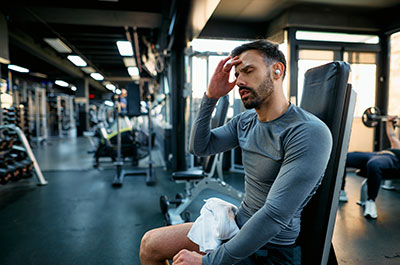If you’re physically active—whether a weekend warrior or an intense athlete—and suffering from hip or shoulder pain, you may have hip or shoulder impingement.
“Hip impingement occurs when someone has extra bone around the hip,” says T. Sean Lynch, M.D., a sports medicine and orthopedic surgeon at Henry Ford Health. “The hip is supposed to be a round peg that fits nicely into a round hole. But for those who have hip impingement, they’ll either have an extra bump of bone coming off the femur (thigh bone) or an extra bump of bone coming off the hip socket, which can make it more like a square peg trying to fit into a round hole. This can cause pain and dysfunction.
“The labrum is a piece of cartilage that goes around the hip socket to make it more stable. It’s kind of like an O-ring or a gasket. So when you have that square peg moving around, it can also cause the labrum to become displaced or torn.”
A shoulder impingement is similar: it occurs when a shoulder tendon rubs against tissue or bone, also causing pain and limited mobility.
Here, Dr. Lynch shares what to know about hip and shoulder impingement.
Q: What are symptoms of hip and shoulder impingement?
A: With hip impingement, you’ll feel pain in the front of your hip or groin—people usually describe it as a deep, aching pain. You’ll feel pain with prolonged sitting, while bending over to put on shoes. You may have difficulty getting in and out of the car. For shoulder impingement, you’ll feel weakness and pain while engaging in overhead activities (for example, trying to reach something on a high shelf) or while playing sports that involve overhead motions like baseball, tennis or volleyball. We can often diagnose both conditions through a physical exam, but diagnosis can be aided with the use of X-ray or MRI.
Q: Who is at risk for hip and shoulder impingement?
A: Hip impingement tends to affect people who are active—it usually develops during the teenage years to late 30s. If you played a lot of sports in middle or high school, you are at a higher risk for hip impingement. For shoulder impingement, you’re at a higher risk if you do a lot of overhead lifting or arm movements. If you’re a tennis player, baseball or volleyball player, you’re more likely to get shoulder impingement. Older populations—ages 40+—tend to be most affected by shoulder impingement.
Q: Are there ways to prevent hip and shoulder impingement?
A: Sometimes impingement stems from genetic issues that are difficult to prevent (for example, a misshapen femoral head) but increasing muscle strength can help prevent symptoms. For hip impingement, if your core, hip and back muscles are strong, it decreases the load so you don’t develop those painful symptoms. Same with shoulder impingement: ensuring those rotator cuff muscles are strong will help prevent pain.
Q: How are hip and shoulder impingements treated?
A: We’ll start by prescribing rest and activity modification. For example, if you run four times a week, we’ll have you switch it up with the elliptical or swimming so you’re not continuously putting the same load across the hip joints. It’s the same with shoulders—we’ll try to cross train the muscles so you’re not putting the same load across the shoulder joints.
We may also prescribe over-the-counter anti-inflammatories. Physical therapy can also do a lot of heavy lifting: it strengthens the muscles around the shoulder and hip joints. If that doesn’t work, the next line of treatment is either a steroid or platelet rich plasma (PRP) injection, which can reduce pain and ease inflammation. We’ll try one injection—two max—with three to four months in between. After that, the next line of treatment is surgery.
Q: What does surgery for hip and shoulder impingement consist of?
A: We’ll do arthroscopic surgery, or minimally invasive surgery, to the hip or shoulder. It allows the surgeon to treat hip and shoulder problems without performing a total joint replacement or making a large incision. Instead, we just make three or four small incisions around the hip or shoulder. We can shave those extra bumps of bone, reattach the labrum to the socket and clean up the rotator cuff so they’re smooth and fit nicely into the socket. Physical therapy is critical to overall recovery to regain strength and confidence. It might take five to six months to get back to the level of activity that you were previously at.
Q: Is surgery always inevitable?
A: It depends upon the demands and physical activities of the patient. It’s hard to treat high-level athletes without surgery. For weekend warriors, it’s about 50/50. Either way, starting with non-operative solutions can really help so that post-op recovery goes smoothly.
To find a doctor or sports medicine specialist at Henry Ford, visit henryford.com or call 1-800-436-7936.
T. Sean Lynch, M.D., is a sports medicine and orthopedic surgeon at Henry Ford Health. He is the head team physician for the Detroit Lions and sees patients at the Henry Ford Center for Athletic Medicine, Henry Ford Medical Center—Royal Oak and Henry Ford Medical Center—Plymouth.



